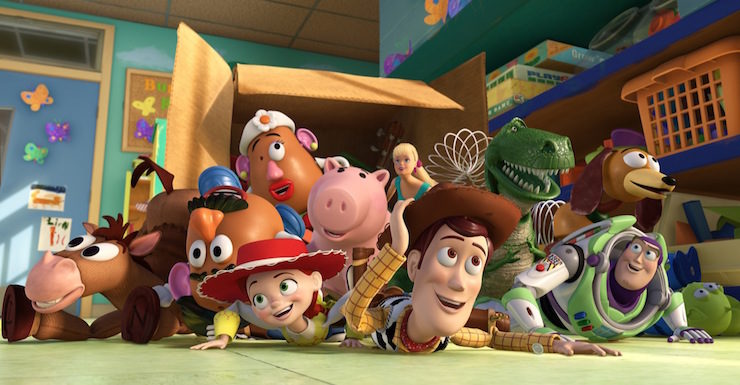Confession time part one: When the idea of a Pixar rewatch came up, I was reluctant.
This film was the main reason why.
Because I remembered what happened the first time I saw this film.
Sobbing.
That’s right.
Sobbing.
Let’s pretend that most of that sobbing came from the toys.
Fortunately, thanks to Blu-Ray/DVD/streaming technology, we can now watch this film with frequent pauses for uncontrollable sobbing appreciation of the fine art and technical work that went into creating this film.
Confession time part two: I had written the above and quite a lot of the stuff below when the news broke that John Lasseter, Chief Creative Officer at Disney/Pixar and one of the three writers of Toy Story 3, would be taking a six month leave of absence from Disney after reports of years of alleged misconduct towards women at both firms. The Hollywood Reporter and other entertainment sites have more details.
My initial response, to be frank, was to just give up—to write The Powers That Be at Tor.com and tell them that I was sorry, so sorry, but I just couldn’t write this post or the rest of the Pixar posts. At least not immediately. That as of now I would be and am seeing every Pixar film influenced by John Lasseter—which is pretty much every Pixar film—as, well, influenced by John Lasseter. That the reports of severe overwork leading to injury now seem, in retrospect, to be not just a Toy Story 2 problem, or a “this is what happens when Steve Jobs is involved” problem, or even a “how much should we sacrifice for art” problem, but something worse. That the tendency of Pixar films to be very heavily male/boy slanted now takes on a different, more ominous meaning.
Speaking of which: Yes, Pixar films have featured some amazing girls and women. But their first film to feature a girl protagonist was also their thirteenth film. Before that, even in films featuring women and girls in major roles, men still dominated.
This ended up having effects beyond Pixar: Disney and Dreamworks executives looked at the success of The Lion King and the male dominated Pixar films and decided that animated feature films needed to be tailored to small boys—who would refuse to see films tailored to small girls. It took the success of the Disney Princess franchise and Frozen to smash this idea to smithereens, but in the meantime, it meant abandoning the old habits of alternating between featuring girls or boys, or featuring both, for several years.
But back to Lasseter. As said, my first response was to drop this series completely. But then I reconsidered. These films aren’t the work or vision of just one guy: they are a group project, the work of hundreds of artists, writers, programmers and actors. Yes, Toy Story 3 features characters that Lasseter created or helped create, characters that by his own admission are among his favorites—but Toy Story 3 was directed not by Lasseter, but by Lee Unkrich, and co-written by Andrew Stanton and Lee Unkrich, and designed and developed by other artists.
Allowing all of their work to be overshadowed, or dismissed, because of the actions of one person—
Well.
We’ll be touching on this again when we reach Brave, but for now, with all of that said, the Pixar rewatch continues. If more painfully than before.
And with that, onto the post!
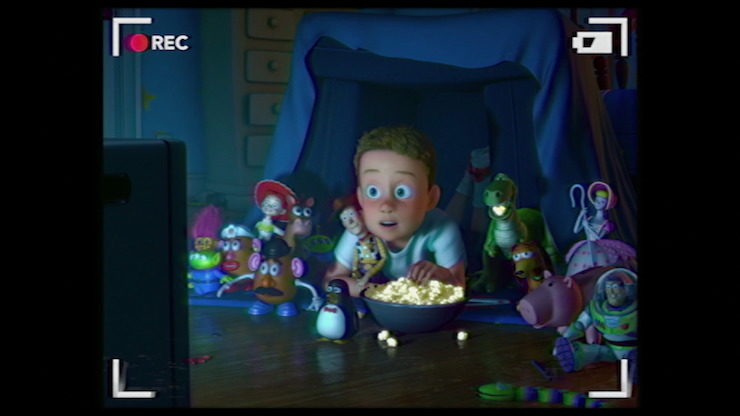
After the successes of the first two Toy Story films, a third was almost inevitable. I say “almost inevitable,” since the development immediately ran into a huge complication: the deteriorating relationship between Disney and Pixar. Their earlier agreement meant that Disney, not Pixar, owned the rights to the Toy Story characters. Steve Jobs had no intentions of allowing Pixar animators to work on a film that the company would receive no money from, and Disney had no intentions of allowing Toy Story characters to go to waste. In 2004, Disney created a new film studio, Circle 7 Animation, and ordered it to begin developing sequels for Toy Story 2, Monsters, Inc., and Finding Nemo, forcing John Lasseter to watch as Disney made plans for another sequel without his input. Lasseter reportedly compared the experience to watching children being adopted by child molesters (one of many remarks made more interesting by the recent allegations.) On Circle 7 Animation’s side, even with around 150 employees, progress on the sequels was slow at best.
Two years later, when Disney purchased Pixar, and placed John Lasseter in charge of both animation departments, Circle 7 Animation had nothing more than an early script, some concept art, and a tentative agreement from some of the Toy Story voice actors to return. One of Lasseter’s first acts was to close down Circle 7, bringing the animators there into Disney and Pixar. His next act was to greenlight Toy Story 3 again, pulling in three more Pixar veterans, Andrew Stanton, Pete Docter and Lee Unkrich (who had previously worked on Pixar films as a film editor and co-director) to develop the story. None of them looked at the early script, which was quickly trashed, developing something new.
The story they created—eventually scripted by Michael Arndt, who would go on from this to script The Hunger Games: Catching Fire and Star Wars: The Force Awakens—turned out to be a surprisingly dark mediation on family, life, and death, complete with a nearly literal descent into hell and some jokes about Barbie and Ken. I’m not the first, and probably won’t be the last, to read Toy Story 3 as a tour of the afterlife for toys. After all, the toys “die” (getting placed in a dark plastic bag without light) then travel to “Purgatory” (a day care center) where they catch glimpses of “Heaven” (a happy room filled with children and toys) which they can’t immediately enter, until they prove themselves worthy, before nearly sliding into a pit of fire, only to be rescued by “THE CLAW”—an object of worship for the three-eyed alien toys.
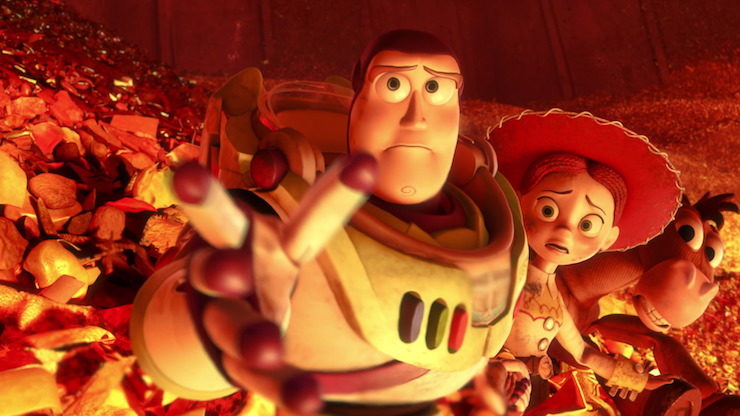
It’s not a perfect fit, of course, given that the toys also spend quite a bit of the film staging a prison break and overthrowing an evil regime, not exactly elements of the typical afterlife story. But those elements do add even more terror to the scene where the toys face death—real death, not just life in an attic—and help set up the ending where the toys really do move on to another life.
Surprisingly, despite this darkness and terror, Toy Story 3 was reportedly the first Pixar film made without any major collapses, breakdowns, 24 hour work days, or other issues. We could argue that this happened because for once, animators felt comfortable releasing their negativity into the film (see the above bit about hell), but truthfully, this seems to have happened for purely pragmatic reasons. To start with, Toy Story 3, unlike many of its predecessors, did not require any vast technical leaps (for instance, figuring out how to get computers to animate fur and water) or new computer processors. That also meant that Pixar animators could turn a teddy bear into a villain without having to worry about how to animate the fur on the teddy bear. Thus, animators could spend less time focusing on computer issues, and more time studying prison break films—to the film’s decided advantage.
It helped, too, that by now, everyone at Pixar and Disney had a certain comfort level with the Toy Story characters and the process of creating Toy Story films—and very little desire to repeat the production issues that had beset the second film. That included the voice actors, almost all of whom returned for this film, with the exceptions of Jim Varney, who had died in 1999, who was replaced by close friend Blake Clarke; Joe Ranft, who had died in 2000 and whose character, Wheezy, was left out of the film; and Annie Potts, reportedly left out after animators decided that her porcelain toy character, Bo Peep, would be unlikely to survive either the prison break or the fall into the incinerator, and the film was going to be scary enough as it was without having an actual toy fracture into a thousand pieces in front of terrified children.
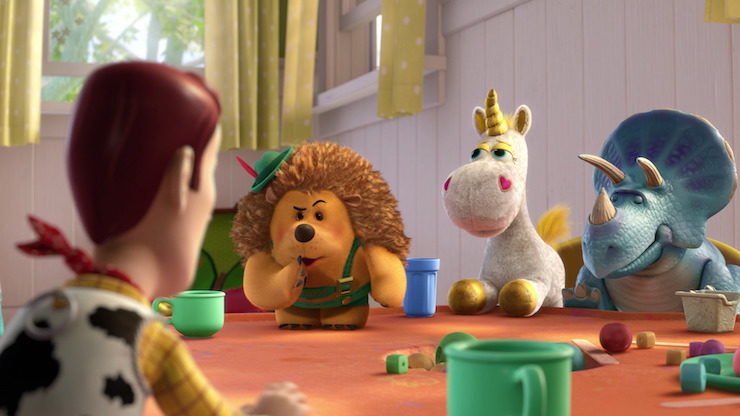
The veteran actors were joined by several actors eager to take even small cameo voice parts because, well, this was a Toy Story film, allowing animators to have fun with a former Mr. Bond playing a character called, well, Mr. Pricklepants.
Animators littered the film with references to other Pixar films—batteries in the film display the Buy n More brand from WALL-E, a little girl wears a Dory Band-aid, and a few cars from Cars show up in the parking lot and on various posters. And of course Pizza Planet makes its inevitable appearance. Pixar also slipped a plush Totoro into the film, as a nod to Disney’s and John Lasseter’s new roles as American distributors for Studio Ghibli films.
All of this fit into a remarkably seamless plot – well, if you ignore the first few minutes, a glorious mishmash of a scene involving trolls, a speeding train, Woody, Buzz and the other toys in something that….ok, makes very little sense, but is fun to watch. As it turns out, this is all a flashback to the glorious old days when Andy played with his toys on a regular basis. Andy is now seventeen, and even an attempt to trick him into play using a couple of cell phones doesn’t work. The toys have to face reality: play time with Andy is over. It’s the first of several tear-jerking moments of the film.
Thanks to a series of unfortunate events, most of the toys find themselves out on the curb, almost thrown away—with Woody unable to get Buster to help. (Buster, now an old dog, has the same opinion about activity as my sixteen-year-old cat: really, it’s for other living creatures unable to appreciate the joy of just sleeping through the day.) Refusing to believe Woody’s explanations for all of this, the toys decide to jump into a donation box and head off to day care. It’s better, they explain, than the incinerator. NEXT tear-jerking moment. What I’m saying is, if you haven’t seen this film, bring Kleenex.

After this, however, matters cheer up, as the toys find themselves trapped in the day care, which turns out to be not the cheery place of endless play that they’d hoped for, but a tyrannical regime run by an Evil Teddy Bear, Lotso, who has a more than a bit of horror in his own past: a moment featuring a baby doll, a clown and a strawberry colored teddy bear left in a corn field, all looking as if they’ve escaped from a horror flick. (The then-head of the MPAA later admitted that giving Toy Story 3 a G rating might have been a slight mistake, in part because of this bit.)
From here, the film segues into what is, animated or not, frankly one of the great prison escape films of all time—and not just because of a hilarious moment where Mr. Potato Head finds, shall we say, something else to stick his parts into. That sounded a lot filthier than the film implies, but I’ll leave it there.
I mean, sure, the entire sequence requires some suspension of disbelief—even more than the suspension of disbelief required, say, to believe that toys jump up and play when we can’t see them. In the case of this film, rendered all the more difficult to believe since the presence of security cameras recording that sort of thing is even a plot point. Assuming that toys can and do jump up and play when we aren’t there, why don’t we have some security cam footage of this kinda thing? But moving on. I’m talking about, for instance, accepting that Mrs. Potato Head can see through her separated body parts even if she’s not currently attached to said body parts—something that also becomes a major plot point.
But it’s also clever, with several edge of your seat moments, and I’m not even talking about the incinerator plot. This is a film that manages to create a suspenseful moment with a roll of toilet paper. It’s that good.
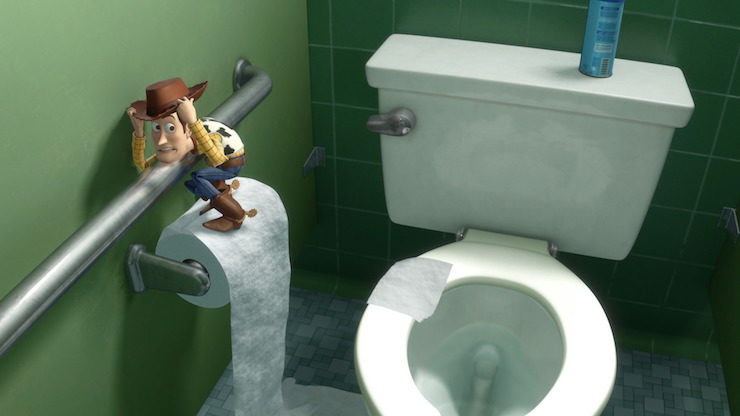
And it’s a Pixar film, so, now is of course a safe time to put away the Kleenex and enjoy a happy ending and—
Look. All I can say about the last few scenes of Toy Story 3 is that, (a) thank you, Hollywood, for creating post-credits and in-credits scenes so that we could have some recovery time for that (and confirm that yes, Barbie has been fully updated on all events), (b) if you have fond memories of any of your toys, and I do, this may well bring all of them back (I won’t confirm or deny that I found myself dreaming of Rabbity, the small stuffed rabbit that fought by my side to ensure that no doll—NONE—would ever have to face the fear of getting eaten by rabbits, but it’s possible that I had some rabbit thoughts), and (c) I can only hope that maybe, just maybe, this will inspire at least some children to hold on to their very special toys, and not let them suffer the fate of whatever happened to Rabbity.
Or, if they can’t, give their toys to the right children. The sorts of children who understand just how important toys are, and how much they need to be played with.
Toy Story 3 was received enthusiastically by critics, and even more enthusiastically by viewers, earning $1.067 billion at the box office, making it the highest grossing film of 2010, and, as of this writing, the third highest grossing animated film, unadjusted for inflation, beaten only by Minions and Frozen. The film received multiple award nominations, including five Academy Award nominations, one for Best Picture, eventually winning for Best Song and Best Animated Features. As with the Cars franchise, however, the true revenue came from the merchandising.
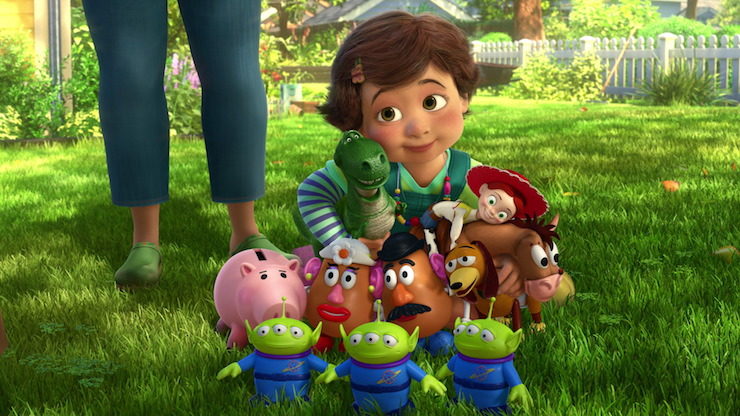
The success convinced Pixar to bow to fan demands—or greed, take your pick—and release two television specials detailing the additional adventures of the Toy Story gang with their new kid, Bonnie: the Halloween special Toy Story of Terror! and the Christmas special Toy Story That Time Forgot. Both specials appear to be well on their way to becoming holiday season staples. And although Toy Story 3 was supposed to the absolutely positively absolutely last Toy Story film, a sequel, Toy Story 4, is planned for a 2019 release.
But before Pixar could get to that, or even start considering story concepts, it had another franchise to pay attention to. One that, in retrospect, probably could have withstood a little more attention.
Cars 2, coming up next.
Mari Ness lives in central Florida.










